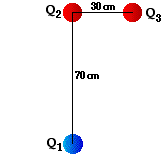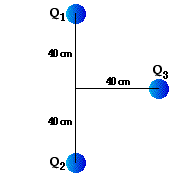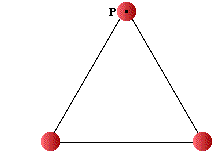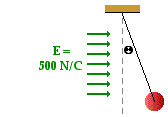Static Electricity: Extra Problems
The problems below are provided as additional problems to
the original set of 33 Static Electricity problems. Just like problems in the original set, these problems consist of a problem, an answer (revealed by clicking a link), an audio guided solution, and links to an
Overview page of formulas and to The Physics Classroom Tutorial pages. The Extra Problems pertain to various aspects of the topic of static electricity - but mainly Coulomb's law of force and electric field strength.
Problem Set A
Problem 1:
Calculate the net charge (in Coulombs) on a substance consisting of an excess of 6.8 x1013 electrons. Indicate the type of charge as either positive or negative.
Problem 2:
Calculate the net charge (in Coulombs) on a substance consisting of a combination of 7.64 x1015 protons and 5.24 x1015 electrons. Indicate the type of charge as either positive or negative.
Problem 3:
Calculate the net charge (in Coulombs) on a speck of dust consisting of a combination of 6.1226x1015 protons and 6.2027x1015 electrons. If negative, then enter a negative answer.
Problem 4:
Two point charges of magnitude 8.64 x10-9 C and 6.84 x10-9 C are separated by a distance of 0.612 m. Find the electric force (in Newtons) of repulsion between them.
Problem 5:
A 6.98 x10-9 C charge is located 4.36 m from a -8.12 x10-9 C charge. Find the electrostatic force (in Newtons) exerted by one charge upon the other.
Problem 6:
Two identical spheres are placed with a distance of 0.450 meters between their centers. One is given a charge of 3.42 x10-9 C and the other a charge of -6.10 x10-9 C. Find the electrostatic force (in Newtons) exerted on one one sphere by the other.
Problem 7:
Determine the mass a pair of protons (in kg) would have to have in order for their gravitational force of attraction to be equal to their electrical force of repulsion.
Problem 8:
The moon and the Earth attract due to their gravitational force. Suppose that the force of attraction was the result of each having a charge of the same magnitude, yet opposite in sign. What quantity of charge (in Coulombs) would they have to have in order to produce the required force? (NOTE: Mmoon = 7.36 x 1022 kg; MEarth = 5.98x1024 kg)
Problem 9:
An electron is released just above the surface of the Earth. A second electron directly below it exerts an electrostatic force on the first just great enough to cancel the gravitation pull towards the Earth. How far (in meters) below the first electron is the second electron? (NOTE: the Earth's mass is 5.98 x 1024 kg.)
Problem 10:
Two point charges of equal magnitude repel each other with a force of 6.04 Newtons when separated by 17.6 cm. Find the magnitude of the charge (in Coulombs). Enter a positive answer.
Problem 11:
The electric force on a point charge of 5.36x10-11 C at some point is 9.2x10-6 N in the + x-direction. What is the magnitude of the electric field (in Newtons/Coulomb) at this location?
Problem 12:
The magnitude of the electric field at a certain location is 6.56x108 N/C. The field is directed east to west. Find the magnitude and direction of the force (in Newtons) acting on a proton placed at this point. Indicate the direction of the force as either east or west.
Problem 13:
Find the magnitude and direction of the electric field (in Newtons/Coulomb) at a distance of 16.36 cm from an electron. Indicate if the direction of the electric field is away from the electron.
Problem 14:
A 2.5-gram rubber balloon is charged to 2.02x10-6 Coulomb and suspended from the ceiling. A sample of animal fur is charged to 6.12x10-6 Coulomb. Assuming that the fur is a 'point charge', determine the distance (in cm) of separation required to produce a force of 7.8 Newtons.
Problem 15:
A 5x10-12 C test charge is placed a distance of 0.61 m from a 6.24 microCoulomb charge. Determine the electric field intensity (in Newtons/Coulomb) at the location of the test charge.
Problem 16:
The electric field at a distance of 0.864 m from a certain charge is found to have a magnitude of 440 N/C. What is the magnitude of the charge (in Coulombs)?
Problem 17:
The proton in the Hydrogen atom creates an electric field which exerts an influence upon 'orbitting' electrons. Determine the magnitude and direction of the electric field (in Newtons/Coulomb) at the location of an electron in the atom. Indicate the direction of the electric field as being either towards or away from the proton. (NOTE: the electron 'orbits' the nucleus at a distance of 0.51x10-10 meters.)
Problem 18:
Find the electric field intensity (in Newtons/Coulomb) at a point midway between two point charges of +8.32x10-9 C and +6.04x10-9 C separated by 37 cm.
Problem 19:
A -7.2x10-9 C charge is located on the x-axis at x = -2.0 m. A 2.8x10-9 C charge is located at x = +5.0 m. A 3.5x10-9 C charge is located at the origin. Determine the net electric force (in Newtons) on the 3.5x10-9 C charge. Indicate the direction of the net force as well.
Problem 20:
Consider the diagram below. Calculate the net electric force (in Newtons) on Q1. GIVEN: Q1 = +4.0 x 10-9 C; Q2 = +5.0 x 10-9 C; Q3 = -7.0 x 10-9 C; d1 = 5.0 cm; d2 = 8.0 cm. Indicate the direction of the net force as well.

Problem Set B
Problem 1:
An electron is accelerated from rest by a constant electric field of magnitude 295 N/C. Determine its final velocity (in m/s) if this acceleration occurs for 5.06x10-8 seconds. (Refer to Table of Constants.)
Problem 2:
 Three charges are arranged as shown in the diagram at the right. Find the magnitude of the net electrostatic force (in Newtons) on Q2. Given: Q1 = -15.0 nC; Q2 = +9.0 nC; Q3 = +11.0 nC. (1 nC = 1 nanoCoulomb = 1x10-9 C)
Three charges are arranged as shown in the diagram at the right. Find the magnitude of the net electrostatic force (in Newtons) on Q2. Given: Q1 = -15.0 nC; Q2 = +9.0 nC; Q3 = +11.0 nC. (1 nC = 1 nanoCoulomb = 1x10-9 C)
Problem 3:
(Referring to the previous problem.) Determine the direction of the net electrostatic force on Q2. Express as a counterclockwise angle (in degrees) of rotation from due East.
Problem 4:
 Three charges are arranged as shown in the diagram at the right. It is known that Q1 = -7.0 nC; Q2 = -4.0 nC; Q3 = -5.0 nC. (1 nC = 1 nanoCoulomb = 1x10-9 C) Find the magnitude of the net electrostatic force (in Newtons) on Q3.
Three charges are arranged as shown in the diagram at the right. It is known that Q1 = -7.0 nC; Q2 = -4.0 nC; Q3 = -5.0 nC. (1 nC = 1 nanoCoulomb = 1x10-9 C) Find the magnitude of the net electrostatic force (in Newtons) on Q3.
Problem 5:
(Referring to the previous problem.) Determine the direction of the net electrostatic force on Q3. Express as a counterclockwise angle (in degrees) of rotation from due East.
Problem 6:
Two small metallic spheres each of mass 0.202 grams are suspended by light strings as pendulums from a common point. Each is given the same electric charge. It is found that the two come to equilibrium when each string is at an angle of 10.0 degrees with the vertical. If the length of each string is 0.608 meters, then what is the magnitude of the charge (in Coulombs) on each sphere?
Problem 7:
A charge of +18.0 x 10-9 C (Q1) and a charge of -10.0 x 10-9 C (Q2) are separated by a distance of 50 cm. Find the location where a third charge of +13.0 x 10-9 C can be placed such that the net electrostatic force is 0.0 N. Express your answer as a x-coordinate location (in cm), with Q1 being located at x=0 cm and Q2 being located at x = +50.0 cm. See diagram below.

Problem 8:
Calculate the net electric field (in N/C) exerted on Q2 in Problem #2 above.
Problem 9:
 Consider the diagram at the right. Three identical point charges (Q = +5.30 nC) are placed on the corners of an equilateral triangle whose sides have a length of 37.5 cm. Determine the magnitude of the net electric field (in N/C) at point P due to the two charges at the base of the triangle.
Consider the diagram at the right. Three identical point charges (Q = +5.30 nC) are placed on the corners of an equilateral triangle whose sides have a length of 37.5 cm. Determine the magnitude of the net electric field (in N/C) at point P due to the two charges at the base of the triangle.
Problem 10:
(Referring to the previous problem.) Determine the direction of the net electrostatic field at point P. Express as a counterclockwise angle (in degrees) of rotation from due East.
Problem 11:
Consider the diagram at the right. The two charges are separated by a distance of 40.0 cm. Q1 has a charge of -3.9 nC and Q2 has a charge of +5.8 nC. Determine the location where the net electric field is 0.0 N/C. Express your answer as a x-coordinate location (in cm), with Q1 being located at x = 0.0 cm and Q2 being located at x = +40.0 cm. See diagram below.

Problem 12:
 A small 3.50-gram plastic ball is suspended by a 22.5-cm long string in a uniform 500 N/C electric field as shown in the diagram at the right. The ball is in equilibrium when the string makes a 13.8-degree angle with the vertical as shown. Determine the net charge (in microCoulombs) on the ball.
A small 3.50-gram plastic ball is suspended by a 22.5-cm long string in a uniform 500 N/C electric field as shown in the diagram at the right. The ball is in equilibrium when the string makes a 13.8-degree angle with the vertical as shown. Determine the net charge (in microCoulombs) on the ball.
Problem 13:
Three point charges lie along the y-axis. A charge Q1 = -5.0 microCoulombs is at y = +7.0 m, and a charge Q2 = +9.0 microCoulombs is at y = +2.0 m. Where must a positive charge Q3 be placed such that the resultant force on it is 0 Newtons? Express your answer as a y-coordinate location (in meters).
Problem 14:
A metal sphere is charged by losing 3.98 x1013 electrons while a second sphere is charged by losing 6.35 x1013 electrons. The two spheres are 18.7 cm apart. Determine the amount of electrostatic force (in Newtons) between the two spheres.
Problem 15:
In the Bohr model of the atom, an electron orbits about a proton in a circular orbit. If the electron were to maintain a constant orbital distance of 4.80 x 10-11 meters, determine the speed (in m/s) which the electron must have in order to maintain a circular orbit at this distance. (Refer to Table of Constants.)
Problem 16:
Four charges are placed in a row as shown in the accompanying animation. There is a +7.0 microcoulomb charge placed at the 10 cm mark, a +4.0 microcoulomb charge placed at the 25.0 cm mark, a +8.0 microcoulomb charged placed at the 70.0 cm mark, and a +6 microcoulomb charge placed at the 90 cm mark. Determine the acceleration (in m/s/s) of a +1.0 coulomb charge placed at the 50.0 cm mark if the +1.0 Coulomb charge has a mass of 12,000 kg. Indicate the direction of the acceleration as well.
Problem 17:
Four charges are placed in a square. There is a 3.0-micro-coulomb charge placed at the (0 cm, 0 cm) mark, a 6.0-micro-coulomb charge placed at the (0 cm, 4 cm) mark, a 3.0-micro-coulomb charge placed at the (4 cm, 4 cm) mark, and an 8.0-micro-coulomb charge placed at the (4 cm, 0cm) mark. Determine the magnitude of the electric field (in Newtons/Coulomb) in the center of the square.
Problem 18:
Two 5.2 kg bowling balls are placed at the bottom of a vertical cylinder. Charge is added to each ball until they repel with enough force to separate the two balls by a distance of 8.0 cm. Assuming the two bowling balls are charged positively and equally, determine the amount of charge (in Coulombs) added to each individual ball.
Problem 19:
Two 1.47 gram balloons are suspended by strings that are 166 cm long. The two balloons establish equilibrium with an angle between the two strings of 13.1 degrees. Determine the charge (in Coulombs) on each balloon. Assume the same amount of charge is on each balloon.